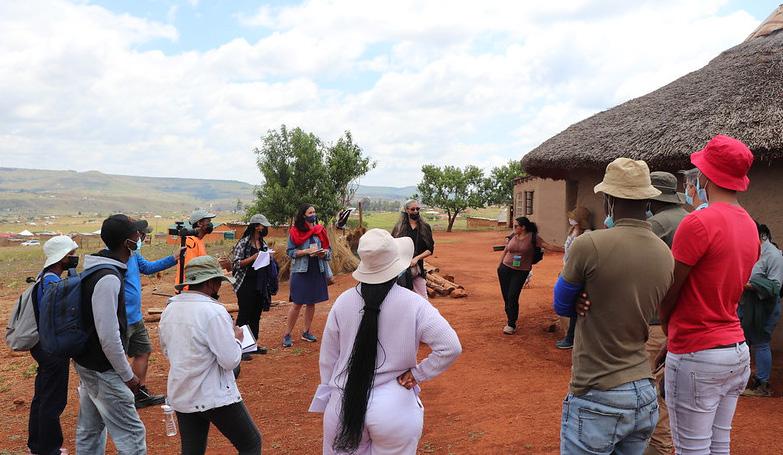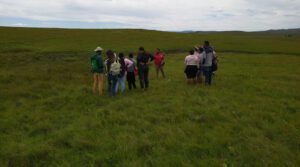Ziyanda Majodina speaks to Jenifer Zungu, project leader: Ecological Infrastructure for Water Security at the South African National Biodiversity Institute (SANBI), about the importance of ecological infrastructure and unlocking its potential to support water security.
Green infrastructure is broadly defined as a strategically planned network of high-quality natural and semi-natural areas with other environmental features designed and managed to deliver a wide range of ecosystem services and protect biodiversity in both rural and urban settings (like bioswales, rainwater harvesting, green roofs and permeable paving). Within this is a subset known as ecological infrastructure. This refers to the naturally functioning ecosystems that generate or deliver valuable services to people. It is the networks of natural healthy lands and working landscapes on which life-supporting ecosystem goods and services depend. Examples of ecological infrastructure include mountain catchments, wetlands, and coastal dunes.The importance of ecological infrastructure
“Some of the services provided by this ecological infrastructure include water and climate regulation, soil formation, and disaster risk reduction. Ecological infrastructure can supplement, and sometimes even substitute, built infrastructure solutions,” says Zungu. She adds that strategic investment in ecological infrastructure can lengthen the lifespan of the existing built infrastructure. “It must be noted that ecological infrastructure supports built infrastructure. For instance, a well-functioning wetland upstream of a dam or wastewater treatment plant will improve water quality.” Ecological infrastructure can support built infrastructure – often with significant cost savings. Degraded ecological infrastructure increases the vulnerability of built infrastructure to damage during extreme events like floods and increases maintenance costs. It is important to have some type of buffering mechanism to protect built infrastructure. Key elements of ecological infrastructure, including mountain catchments and corridors of natural vegetation, are often located in rural areas. Rehabilitating and maintaining ecological infrastructure contributes to diversifying rural livelihood options – on one hand through direct job creation, and on the other by strengthening economic sectors such as sustainable farming and ecotourism. Rural communities usually rely directly on ecological infrastructure for goods and services – e.g. getting their drinking water directly from rivers – and tend to be the most immediately and severely affected when ecosystems become degraded. Furthermore, ecological infrastructure helps to mitigate risk. Well-managed ecological infrastructure can buffer human settlements and built infrastructure against extreme events like landslides, floods and droughts, playing a crucial and cost-effective role in disaster risk reduction. For example, coastal ecosystems such as dunes, mangroves and kelp beds reduce the impact of storm surges on coastal settlements. Healthy ecological infrastructure will play an important role in climate change adaptation and functioning ecological infrastructure is key to building resilience in extreme weather events. “With climate change, there is an increase in the frequency and magnitude of extreme events. The western part of the country is expected to become hotter and drier with climate change, while the eastern parts will become wetter. Healthy riparian zones and wetlands will create a ‘sponge effect’ of slowing down water from storm surges, minimising erosion, and sustaining base flows in rivers,” explains Zungu Another important advantage is job creation. Healthy ecological infrastructure supports a range of economic sectors, directly and indirectly. Restoring and maintaining ecological infrastructure creates jobs because it is usually a labour-intensive endeavour, such as clearing alien invasive plants. “We have only scratched the surface of this job creation potential. Many of the jobs would be in the poorest parts of the country with the least access to other employment opportunities. The 2011 Green Jobs report by the Industrial Development Corporation and the Development Bank of Southern Africa highlights that the bulk of the jobs related to the green economy is likely to come from natural resource management,” maintains Zungu. “If we don’t rehabilitate or restore ecological infrastructure, we run the risk of the services they render deteriorating or potentially losing that function completely,” she says.
Funding
Zungu emphasises that there needs to be an investment in both ecological and built infrastructure. “The work done around ecological infrastructure should support built infrastructure and can even in some instances play a replacement role where some of the built infrastructure is not functioning properly.” She adds that the costs to rehabilitate ecological infrastructure are far lower than the costs to replace it. Furthermore, it may be cheaper to rehabilitate the ecosystems concerned than to keep repairing or replacing the built infrastructure. “When funding built infrastructure, it is important to consider the ecological infrastructure that supports it and any costs linked to the maintenance of that ecological infrastructure.” We need to explore to what extent existing funding streams linked to the development of built infrastructure incorporate ecological infrastructure, as well as the opportunities to do so where ecological infrastructure is not currently considered. For instance, if an investment is made in ecological infrastructure in the upper catchment of a dam (where there may be a risk of siltation), this could result in less siltation (and more water capacity) as well as better quality water. New funding streams also need to be considered, as well as public-private partnerships (PPPs) along with blended finance models.“Natural capital accounting (NCA) refers to the systematic, reliable and regular measurement of stocks and flows of natural resources and ecosystems, so that their state – as well as the benefits they provide to society – can be recognised, understood and integrated into policy, planning and decision-making. NCA thus becomes an important tool in our work to encourage the investment in ecological infrastructure,” explains Zungu.
“Financiers, environmental specialists and engineers need to work more closely together when planning for infrastructure. There is a need to consider the lifespan of the built infrastructure, its return on investment, as well as the risks associated when we don’t invest in the ecological infrastructure that supports that built infrastructure. There needs to be a holistic approach when planning, building and maintaining infrastructure,” she adds. Zungu states that it is encouraging to see that environmental engineers are playing a bigger part in infrastructure projects and that there are shifts in approaches to the planning, construction and maintenance of infrastructure.Ecological Infrastructure for Water Security Project
Launched in 2018 and led by SANBI, the Ecological Infrastructure for Water Security Project focuses on unlocking the potential of ecological infrastructure’s contribution toward water security. It aims to show how ecological infrastructure can support and enhance the investment of water-related built infrastructure. “A key part of the project is to capture, synthesise and share the knowledge generated from it. We focus on strengthening and creating an enabling environment for ecological infrastructure to be considered by developing natural capital accounts and influencing policy in favour of ecological infrastructure,” adds Zungu. “We want to see ecological infrastructure being embedded more in legislation, strategy documents, guideline documents and frameworks. It has been encouraging to observe the inclusion of ecological infrastructure in the National Water and Sanitation Masterplan, and the National Water Security Framework,” she says. The project works in two demonstration catchments:- Berg-Breede, Western Cape, which supplies water to the City of Cape Town
- Great uMngeni, KwaZulu-Natal, which supplies water for most of eThekwini Municipality.
- scaling up investments in restoring and maintaining ecological infrastructure
- building on work initiated through natural resource management programmes such as Working for Water and Working for Wetlands that support job creation and livelihoods
- planning and working in a collaborative manner through co-developing solutions for the management and rehabilitation of ecological infrastructure








